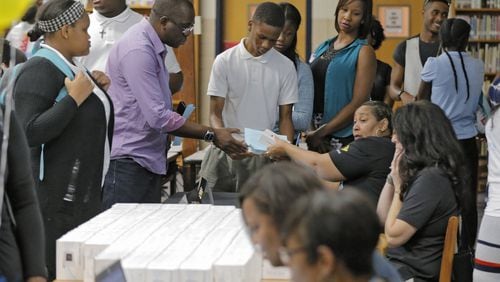The DeKalb County School District is handing out more than 70,000 desktops and laptops to teachers and students hoping to increase classroom collaboration between students and with teachers while boosting parental involvement.
Gary Brantley, the district’s chief information officer, said among the top reasons for the $27 million purchase is to make sure the district’s students are ready when they head to college.
Computer technology has become an everyday teaching tool in public schools and colleges, and DeKalb’s initiative is a response to a problem: Students don’t all have the same access to it.
“We have a lot of kids — especially in our underserved regions as it related to those who have the ability to do for themselves — who are coming out not really understanding how to do basic tasks, PowerPoint presentations, word processing,” he said. “They’re unable to live with (technology).”
The district received information from several university partners, including Georgia Tech and the University of Georgia, that told them students from the DeKalb County School District struggle with classroom technology when they get to college, often because they've not been exposed to what's being used currently.
“That’s kind of my motivation, to get that equity gap,” Brantley said. “They can’t enter college without a PC, and knowing how to operate it.”
Mauise Ricard III, Morehouse College’s interim vice president of information technology and chief information officer, said a clear gap exists with students entering his institution, mostly because the students have little to no experience with the instructional tools used on campus.
“Most students aren’t that far advanced,” he said. “There are tools out there they’ve not been exposed to.”
For DeKalb, it’s important because nearly two-thirds of its 5,267 students who graduated in 2015 went on to some sort of postsecondary education program immediately after graduation. About 17 percent of the students entered straight into the job force. District officials could not account for 22 percent of the students.
Data also show that about 27 percent of those students took remedial math and 14 percent took remedial English courses upon beginning their postsecondary studies.
The district recently announced its Digital Dreamers initiative, a two-year program providing students with laptops and Internet access through wireless hotspots. Eligible middle- and high-school students will receive hotspots donated by Sprint and Columbia University. The program guarantees students have access to the district’s online learning resources.
There is evidence that using technology also has its drawbacks.
“Computers and Productivity: Evidence from Laptop Use in the College Classroom,” published in the Economics of Education Review earlier this year found that using laptops harmed the grades for students, especially male and low-performing students. Those factions were scoring half a grade lower than students who took notes using pen and paper.
“That both laptop-required and laptop-prohibited courses predict that laptops significantly worsen academic performance and both approaches are robust to a series of controls provides compelling evidence that laptops, in fact, worsen academic performance,” the report states.
Despite such worries, technology has found its way to the forefront in education lesson plans as school districts work to increase student achievement.
According to data compiled from various sources by PracTutor, an online math and language arts learning portal, 77 percent of teachers use the internet for instruction, more than half of schools have a wireless network and about 40 percent of teachers report students use computers during classroom instruction.
At Gwinnett County Schools, all teachers have virtual classrooms and pages for students to browse for coursework. It’s part of the district’s eClass (Digital Content Learning Asessment and Support System) initiative.
“What we’re trying to do is extend the work done in the classroom through technology,” said Tricia Kennedy, executive director for the eClass transformation. “There is definitely appropriate use for technology as a tool. We do allow our students to bring their personal devices and use on our secure Wi-Fi network. We feel like it’s really, really important for students to use the technology so they’re comfortable with and able to use it.
“We’re investing in that as part of their learning.”
In recent months, Sprint has partnered with several metro Atlanta school districts, including DeKalb, to offer wireless hotspots to students. The company announced this week it was giving smartphones, tablets and wireless hotspots to 1,500 Atlanta Public Schools students, part of its 1Million Project to close the "homework gap" for students who don't have internet access at home and struggle to complete class work that requires online research.
Ricard, at Morehouse, mentioned summer programs where students are given access to some of the tools to give them a better understanding of what would be used once the school year commences.
“Most students, from an instructional level, are up to speed with your Facebooks and Twitters,” he said. “But when it comes to Blackboard, a learning management system, they’re not used to using that curriculum.”







